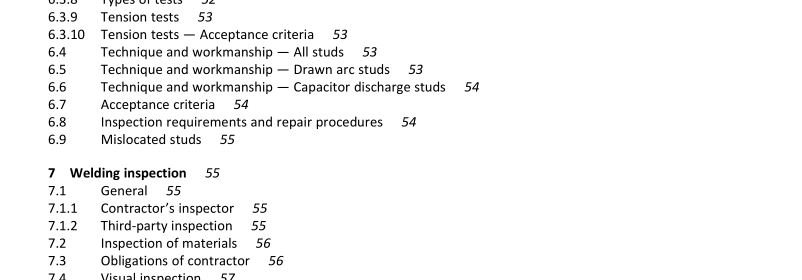CSA W59.2-18 pdf download – Welded aluminum construction.
3 General requirements 3.1 Qualification requirements 3.1.1 Contractor When mandated in the contract or in the governing design Standard,* all contractors performing work under this Standard shall comply with CSA W47.2 for welded fabrications. * Examples: CSA S6 and CSA S157. 3.1.2 Welding processes 3.1.2.1 This Standard covers the following welding processes: a) gas metal arc welding (GMAW); b) gas tungsten arc welding (GTAW); c) plasma arc welding (PAW); d) friction stir welding (FSW); and e) stud welding (SW) by the arc and capacitor discharge. Filler metals and allied materials for the various processes shall conform to the requirements in AWS A5.10/A5.10M, except for stud welding, which shall conform to the requirements of Clause 3.1.2.2 of this Standard. Other welding processes may be used with the approval of the engineer. Any welding process not covered directly by AWS A5.10/A5.10M or not written in this Standard shall be subject to the acceptance provisions of CSA W47.2. Note: Clause 10 provides specific requirements for friction stir welding (FSW). 3.1.2.2 Stud welding procedures shall conform to the requirements of Clause 6 and their approval shall be based on satisfactory tests prescribed in Clause 6.
3.1.3 Selection of type of groove and welding procedure Unless otherwise specified in the contract documents, the selection of the type of groove, the geometry of preparation, the welding process, and the related welding procedures shall be the responsibility of the contractor’s engineer. (See Annex A for recommended joint geometries.) 3.2 Base metal 3.2.1 Aluminum base alloys to be welded under this Standard shall conform to the requirements of the CSA HA Series or ASTM Series listed in Clause 3.2.2 or other recognized specification of equivalent welding quality as determined by the contractor’ engineer and approved by the engineer. Equivalent welding quality shall be established on the basis of composition. 3.2.2 Aluminum base alloys to be welded under this Standard shall conform to the requirements of CSA HA series or ASTM, in the following Aluminum Association alloy classifications: a) Wrought alloys: i) 1XXX: 1060, 1100; ii) 2XXX: 2219; iii) 3XXX: 3003, Alclad 3003, 3004, Alclad 3004; iv) 5XXX: 5005, 5050, 5052, 5083, 5086, 5154, 5254, 5454, 5456, 5652; v) 6XXX: 6005, 6005A, 6061, Alclad 6061, 6063, 6082, 6351; and vi) 7XXX: 7005. b) Cast alloys: i) A201.0; ii) 354.0; iii) C355.0; iv) 356.0 v) A356.0; vi) 357.0; vii) A357.0; viii) 359.0; ix) 443.0; x) A444.0; xi) 514.0; and xii) 535.0. 3.3 Welding terminology Most of the welding terms used in this Standard are defined in AWS A3.0M/A3.0. See Annex E for a selected list of definitions derived from that Standard. Annex E also includes definitions of terms used in this Standard that are not covered in AWS A3.0/A3.0M. See also Figure 3.1.
3.4.2 Symbols convention for grooves welded from both sides with backgouging The use of GTSM (gouge to sound metal) in the tail of the welding symbol designates that a complete joint penetration groove weld is to be produced. The contractor may choose to make the GTSM reference a general note on the shop or erection drawing. Alternatively, the contractor may identify clearly to the engineer all groove welds requiring such backgouging operations on the design documents, thus qualifying them as complete joint penetration groove welds. For complete joint penetration groove welds, as specified above, the symbol need not include the designations of the effective throat “(E)” for each side of the joint.
5.1.4 Welding shall not be done in a draft or wind unless the weld is protected by a shelter. This shelter shall be of material and shape appropriate to reduce wind velocity in the vicinity of the weld to a maximum of 8 km/h (5 mph).Welding shall not be done when the adjacent metal temperature within a distance not less than the metal thickness or 75 mm (3 in) is lower than 10 °C (50 °F). Maximum temperatures shall not exceed those specified in Clause 5.7. 5.1.5 The sizes and lengths of welds shall be not less than those specified by design requirements and detail design documents, nor shall they be substantially in excess of those requirements without approval of the engineer. The location of welds shall not be changed without approval of the engineer. 5.1.6 Backgouging shall produce a groove contour substantially conforming with groove profile dimensions as specified in the Annex A for the welding process to be used. Its depth shall be adequate to ensure complete penetration into the previously deposited weld metal for the welding process to be used. Suitable access to the root shall be maintained.CSA W59.2-18 pdf download.
